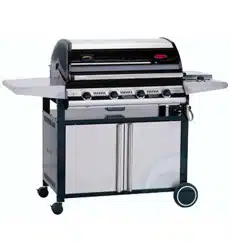Loading ...
Loading ...
Loading ...

10
Connection to Barbecue & Gas Supply
Before You Begin
Check the gas type label as described in the section titled “The Gas Supply”.
Ensure all considerations such as clearances from combustibles listed in the “Locating Your Barbecue” section
are adhered to.
Warning: Contact your local municipality for any building codes regulating the installation of outdoor barbecue
appliances. Outdoor installations must conform to local codes or, in the absence of local codes, with the
following:
USA: National Fuel Gas Code, ANSI Z223.1/NFPA 54
CAN: CGA: B149.1 Natural Gas & Propane Installation Code.
AUST/NZ: Australian Standards Code AS: 5601
as well as the requirements of any local council, gas, electricity authority or other statutory regulation.
Flexible PVC hose assemblies supplied must not be exposed to temperatures in excess of 60°C (140°F). DO
NOT expose to the sun’s direct heat and DO NOT allow the hose to come in contact with the hot surface of
the barbecue body.
Fixed Installation - Piped Natural Gas or LPG/Propane
Fixed installations should be carried out by a qualified gas fitter. BeefEater
barbecues are designed as low-pressure appliances.
Gas connection: Fit the hose directly to the barbecue inlet located on the right
side of the appliance using either hard plumbing, or a flexible hose connected to a
bayonet point. Refer to AS 5601 or your local installation code for pipe sizing details.
Secure all joints spanner (wrench) tight but do not over-tighten.
Pressure testing: Test gas pressure by removing the last burner from the left hand
side of the barbecue and attaching a hose and pressure gauge to the end of the
gas valve. Turn on 2 burners and check the pressure. Inlet pressure should be 1.00
kPa / 4.0” WC for natural gas, or 2.75 kpa / 11”WC for LPG/propane. The barbecue
appliance must be isolated from the gas supply piping system by closing its manual
shutoff valve during any pressure testing of the gas supply piping system.
Australia only: For mobile trolley installations that use flexible hosing to connect to
natural gas, a chain or similar restraining device must be fitted to prevent strain on the gas supply line. One
end of the chain should attach to the barbecue; the other end should attach to a fixed structural point close to
where the hose connects to the gas piping. The chain must be at least 30% shorter than the gas supply line.
In this way, if the barbecue is accidentally moved, the chain stops the barbecue from stretching the hose.
On completion: The appliance must be tested for safe and proper operation on completion of installation.
Proceed to leak test.
Mobile Installation - Portable LPG
When installing a portable LPG cylinder, the following must be observed:
The hose must not exceed 1.50m in length.
Gas cylinders must be stored outdoors, out of reach of children, and must not be stored in a building, garage
or any other enclosed area.
IMPORTANT:
The cylinder supply system must be arranged for vapour withdrawal. This normally means the cylinder
must be upright.
Do not store a spare LPG/propane cylinder under or near this appliance.
Never fill the cylinder beyond 80% full.
If these directions are not followed exactly, a fire causing death or serious injury may occur.
Only one gas cylinder may be attached to the appliance at any one time.
•
•
•
•
•
•
•
bbq.indd 10 3/02/2006 15:19:04
Loading ...
Loading ...
Loading ...
